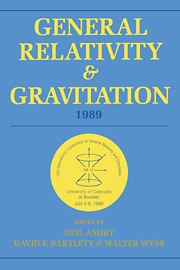 General Relativity and Gravitation, 1989
General Relativity and Gravitation, 1989 Book contents
- Frontmatter
- Contents
- Preface
- Conference committees
- Part A Classical relativity and gravitation theory
- WORKSHOPS
- Part B Relativistic astrophysics, early universe, and classical cosmology
- WORKSHOPS
- Part C Experimental gravitation and gravitational wave detection
- WORKSHOPS
- C1 Solar system and pulsar tests of gravitation
- C2 Earth-based gravitational experiments
- C3 Resonant bar and microwave gravitational wave experiments
- C4 Laser gravitational wave experiments
- Part D Quantum gravity, superstrings, quantum cosmology
- WORKSHOPS
- Part E Overviews-past, present, and future
C1 - Solar system and pulsar tests of gravitation
Published online by Cambridge University Press: 05 March 2012
- Frontmatter
- Contents
- Preface
- Conference committees
- Part A Classical relativity and gravitation theory
- WORKSHOPS
- Part B Relativistic astrophysics, early universe, and classical cosmology
- WORKSHOPS
- Part C Experimental gravitation and gravitational wave detection
- WORKSHOPS
- C1 Solar system and pulsar tests of gravitation
- C2 Earth-based gravitational experiments
- C3 Resonant bar and microwave gravitational wave experiments
- C4 Laser gravitational wave experiments
- Part D Quantum gravity, superstrings, quantum cosmology
- WORKSHOPS
- Part E Overviews-past, present, and future
Summary
In the plenary talk on solar system tests of relativistic gravitation, Irwin Shapiro gave a summary of the present state of the experiments, including a new test of the geodetic precession effect using lunar laser ranging data. The contributed papers at this workshop, by contrast, seemed to look more to the future. What will be the next generation of gravitational experiments in space and what preparations are required now in order that these tests may be successfully accomplished? The workshop began with a mini-workshop which discussed a new NASA program of technology development directed toward future experimental tests of relativistic gravitation. Ron Hellings of JPL began with an overview of the program and discussed two of the studies that are presently underway. Work to improve the accuracy of spacecraft ranging systems could pay immediate dividends of improved accuracy of tests of relativity on many planetary missions. Improvement from the accuracy that was available on the Viking landers (about 10 m) to a limit of 10 cm is the goal of work at JPL by Larry Young and collaborators. Also at JPL there is being pursued by Steve Macenka and Bob Korechoff a study of the capability of full-aperture metrology in optical systems. This technology seeks to use an auxiliary laser signal, sharing the optics in an astrometric telescope, to monitor small changes in the optical path, in order to allow the optics to be actively stabilized.
- Type
- Chapter
- Information
- General Relativity and Gravitation, 1989Proceedings of the 12th International Conference on General Relativity and Gravitation, pp. 341 - 344Publisher: Cambridge University PressPrint publication year: 1990


